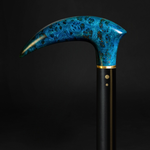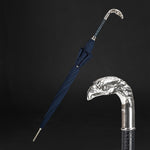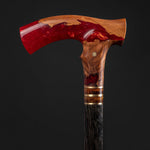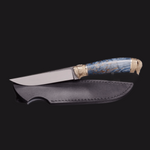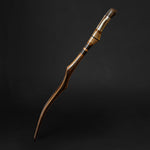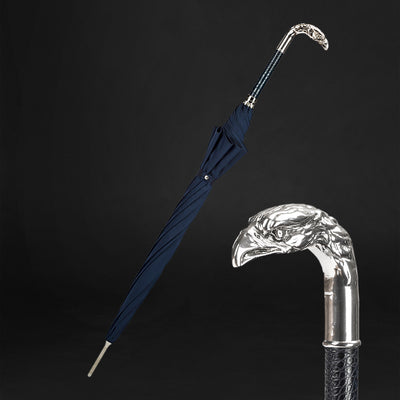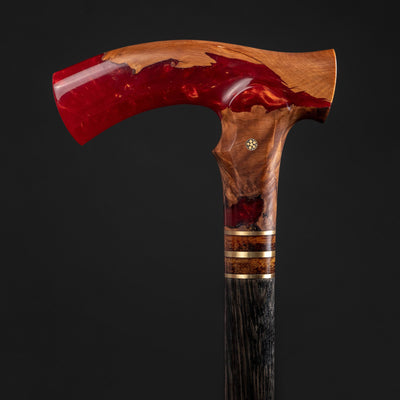You have no items in your shopping cart.
Recent Posts
-
Why an Elegant Cane Is a Thoughtful Gift for Loved Ones?
-
The Art of Christmas Design: Walking Canes That Celebrate the Season in Style
-
How an Ergonomic Walking Cane Handle Prevents Hand and Wrist Strain?
-
How to Walk With a Cane Correctly to Avoid Back or Shoulder Strain?
-
5 Common Mistakes People Make When Buying a Walking Cane (and How to Avoid Them)
-
How to Choose a Walking Cane That Reflects Your Personality (Not Just Your Needs)?
MOST POPULAR NOW
18
Jul
In the realm of walking aids and mobility devices, the right height plays a crucial role in providing comfort, stability, and support. Whether you're considering using a walking stick for medical reasons or simply for enhancing your outdoor adventures, understanding the benefits of the correct height is paramount. In this comprehensive article, we will delve into the reasons why the right height matters when using a walking stick, explore the multitude of benefits it offers, and provide an overview of the content you can expect to find here.
Choosing the right height for your walking stick
Benefits of using a walking stick
1. Enhanced stability and balance
One of the primary benefits of using a walking stick set at the right height is improved stability and balance. By having a walking stick that is tailored to your specific needs, you can significantly reduce the risk of falls and accidents, particularly when traversing uneven terrains or navigating through challenging environments. The stick acts as an extension of your arm, providing an additional point of contact with the ground, allowing you to distribute your weight more evenly and maintain a steady gait.
2. Reduced joint and muscle strain
Walking sticks, when adjusted to the correct height, can effectively reduce joint and muscle strain. By alleviating some of the pressure exerted on your lower limbs, the stick absorbs a portion of your body weight, easing the burden on your knees, hips, and ankles. This reduction in strain is especially beneficial for individuals with conditions such as arthritis or those recovering from injuries. The right height ensures that the walking stick offers optimal support without causing additional discomfort or placing undue stress on your body.
3. Posture support and spinal alignment
Maintaining proper posture is essential for overall health and well-being. A walking stick set at the appropriate height promotes good posture by providing support and aligning your spine correctly. As you walk with a walking stick, it encourages an upright position, preventing slouching or hunching, which can lead to back pain and muscle imbalances. By promoting a natural, aligned posture, a walking stick contributes to better spinal health and reduces the risk of developing posture-related issues.
4. Increased endurance and energy conservation
Using a walking stick at the right height can also enhance your endurance and conserve energy during long walks or challenging activities. By engaging your upper body and utilizing the stick as a propulsive force, you can offload some of the weight-bearing burden from your legs, allowing you to walk for more extended periods without feeling fatigued. The stick acts as a support mechanism, enabling you to distribute your effort more evenly throughout your body and sparing your lower limbs from excessive strain.
5. Versatility and adaptability
Walking sticks are incredibly versatile and adaptable, catering to a wide range of individuals with varying needs. The right height ensures that the stick is customized to your height, arm length, and walking style, maximizing its effectiveness and usability. Whether you're exploring rugged hiking trails, strolling through city streets, or enjoying a leisurely walk in the park, a walking stick adjusted to the appropriate height can accompany you seamlessly, offering stability, confidence, and support wherever your journeys take you.
Overview of the article's content
In this article, we have discussed the importance of the right height when using a walking stick and explored its numerous benefits. We covered the enhanced stability and balance provided by a properly adjusted stick, reducing joint and muscle strain, promoting good posture and spinal alignment, increasing endurance and energy conservation, as well as highlighting the versatility and adaptability of walking sticks.
By understanding the significance of the correct height and utilizing a walking stick that suits your unique requirements, you can optimize your mobility, minimize discomfort, and embrace a more confident and independent lifestyle.

Understanding walking stick height
Importance of proper height for stability and support
When it comes to using a walking stick, the importance of having the proper height cannot be overstated. A walking stick that is adjusted to the right height provides enhanced stability and support, making it a valuable companion for individuals seeking assistance with balance and mobility. Whether you require a walking stick for medical reasons or simply want to enjoy outdoor activities with increased confidence, understanding the significance of the correct height is essential.
Factors to consider when determining the ideal height
Determining the ideal height for your walking stick involves considering several factors that will ensure optimal comfort and functionality. Let's explore these factors in detail:
1. User's height and posture
One of the primary factors to consider when determining the height of a walking stick is the user's height and posture. The stick should be proportionate to your height to ensure that it provides adequate support and stability. Stand upright in your normal walking posture and have someone measure the distance from the ground to the crease of your wrist. This measurement will serve as a starting point for adjusting the walking stick to the correct height.
2. Walking terrain and conditions
The type of terrain and conditions in which you will be using the walking stick is another crucial consideration. For example, if you plan to use the stick on uneven or hilly terrains, you might want to adjust it slightly longer to accommodate for the incline. Conversely, if you primarily walk on flat surfaces, a shorter stick may be more suitable. It's important to assess the environments in which you'll be using the walking stick to ensure that it is set to an appropriate height for optimal stability and ease of use.
3. Personal preferences and comfort
Personal preferences and comfort should also factor into the determination of walking stick height. Some individuals may prefer a slightly higher stick to engage more upper body muscles during use, while others may find a lower stick more comfortable. Experiment with different heights and pay attention to your comfort level and overall ease of movement. Ultimately, the height that feels the most natural and comfortable to you will be the ideal height for your walking stick.
Exploring different types of walking sticks and their height adjustments
Walking sticks come in various types, each offering unique features and benefits. Let's explore three common types of walking sticks and how their height adjustments work:
1. Traditional wooden walking sticks
Traditional wooden walking sticks are a classic choice, often crafted from durable and aesthetically pleasing materials such as oak or maple. These sticks typically come at a fixed height, and adjusting them might require professional assistance. To ensure the correct height, follow the guidelines mentioned earlier and have a walking stick expert modify the length accordingly.
2. Adjustable telescopic walking sticks
Adjustable telescopic walking sticks provide versatility and convenience. These sticks feature multiple sections that can be extended or retracted to achieve the desired height. Adjusting the height is usually as simple as loosening a locking mechanism, extending or retracting the sections, and securely locking them into place. This type of walking stick is ideal for individuals who desire flexibility and the ability to fine-tune the height based on different walking conditions.
3. Folding walking sticks
Folding walking sticks offer portability and compactness, making them an excellent choice for individuals on the go. These sticks can be easily folded and unfolded, allowing for convenient storage and transportation. Some folding walking sticks also come with adjustable height options, providing flexibility for users to customize the stick to their preferred height. Follow the manufacturer's instructions to adjust the height of a folding walking stick correctly.
In conclusion, understanding walking stick height is crucial for achieving stability, support, and comfort during mobility. Consider factors such as user height, posture, walking terrain, and personal preferences when determining the ideal height. Additionally, explore different types of walking sticks, such as traditional wooden sticks, adjustable telescopic sticks, and folding sticks, to find the one that suits your needs best. With the right height and a well-suited walking stick, you can enhance your mobility and enjoy the freedom to navigate various environments with confidence.
Measuring and adjusting walking stick height
Step-by-step guide to measuring the correct height
When it comes to using a walking stick, measuring and adjusting the height correctly is essential for optimal comfort and support. Here is a step-by-step guide to help you measure the correct height for your walking stick:
1. Proper posture and positioning
Stand upright in your normal walking posture, wearing the shoes you typically use when walking with the stick. Ensure that your feet are shoulder-width apart and your arms are relaxed by your sides. Maintaining proper posture and positioning is crucial for accurate height measurement.
2. Measuring from wrist to ground
Have someone assist you in measuring the distance from the ground to the crease of your wrist. This measurement will serve as a starting point for determining the correct height of your walking stick. Use a measuring tape or ruler to obtain an accurate measurement.
Adjusting the height of various walking stick types
Different types of walking sticks offer various methods for adjusting their height. Here's a guide to adjusting the height of three common walking stick types:
1. Traditional walking sticks
Traditional walking sticks often come at a fixed height, but they can be modified to suit your specific needs. To adjust the height of a traditional walking stick:
- Seek professional assistance from a walking stick expert or a knowledgeable craftsman.
- Based on the measurement obtained earlier, the expert will trim the stick to the correct length.
- Ensure that the stick is trimmed from the handle end to maintain the balance and proportions.
2. Telescopic walking sticks
Telescopic walking sticks are adjustable and provide versatility in height customization. To adjust the height of a telescopic walking stick:
- Locate the locking mechanism on the stick, typically found near the handle or within the sections of the stick.
- Loosen the locking mechanism by twisting it or releasing the latch, depending on the design.
- Extend or retract the sections of the stick to achieve the desired height.
- Once the desired height is reached, securely lock the sections into place by tightening the locking mechanism.
3. Folding walking sticks
Folding walking sticks offer both portability and height adjustability. To adjust the height of a folding walking stick:
- Follow the manufacturer's instructions for your specific folding walking stick model, as the adjustment mechanisms may vary.
- Look for buttons, clips, or locks near the joints of the stick.
- Press the buttons, release the clips, or unlock the locks to allow the stick to extend or retract.
- Adjust the height by extending or retracting the sections of the stick.
- Once the desired height is achieved, ensure that the buttons, clips, or locks securely hold the stick in place.
Always refer to the manufacturer's instructions or seek professional guidance when adjusting the height of your walking stick to ensure proper usage and maintain its functionality.
In conclusion, measuring and adjusting the height of your walking stick accurately is crucial for optimal comfort and support. By following the step-by-step guide to measuring the correct height and understanding the adjustment methods for various walking stick types, you can customize your walking stick to suit your specific needs. Remember to prioritize proper posture and seek professional assistance if needed. With a properly adjusted walking stick, you can enjoy enhanced stability, support, and mobility.
Finding the right height for different activities
When using a walking stick, finding the right height is crucial for optimal performance and comfort. The ideal height varies depending on the activity or terrain you'll be engaging in. Let's explore the appropriate heights for different activities:
Walking on even surfaces
1. Proper height for general walking
For walking on even surfaces such as sidewalks or indoor spaces, the general rule of thumb is to set your walking stick height at the level of your wrist crease when standing up straight with your arms relaxed by your sides. This ensures that the stick provides adequate support without causing strain on your joints.
2. Height considerations for brisk walking or exercise
If you plan to engage in brisk walking or exercise with your walking stick, you may consider slightly adjusting the height. Some individuals prefer setting the stick height a few inches higher than the wrist crease to engage more upper body muscles during these activities. Experiment with different heights to find the one that feels most comfortable and effective for your exercise routine.
Hiking and trekking
1. Optimal height for uphill and downhill hiking
When hiking uphill, it's recommended to shorten the height of your walking stick by a few inches. This adjustment allows for better stability and balance while ascending steep inclines. Conversely, when hiking downhill, extending the walking stick slightly longer than your general walking height can provide additional support and help alleviate strain on your knees and joints.
2. Adjusting height for different terrains
Different terrains may require height adjustments for your walking stick. On flat or moderate terrains, you can follow the general walking height guidelines. However, when traversing uneven or rugged terrain, such as rocky paths or forest trails, consider setting the stick slightly longer to account for the irregularities and provide enhanced stability. Make sure to assess the terrain beforehand and adjust the stick height accordingly to ensure safe and comfortable hiking.
Walking on uneven or rugged terrain
1. Ideal height for stability and balance
When walking on uneven or rugged terrain, stability and balance become even more crucial. Set the walking stick height slightly higher than the general walking height to provide increased stability and support. The additional height compensates for the uneven ground and helps you maintain balance while navigating through challenging surfaces.
2. Safety precautions to consider
While using a walking stick on uneven or rugged terrain, it's essential to prioritize safety. Ensure that the stick is securely adjusted to the appropriate height to prevent any accidents or instability. Additionally, choose a walking stick with a sturdy grip and consider using rubber tips or spikes for added traction, depending on the terrain. Always be cautious and mindful of your surroundings to minimize the risk of slips or falls.
Using a walking stick for rehabilitation or medical purposes
1. Appropriate height for post-surgery or injury recovery
When using a walking stick for rehabilitation or medical purposes, it's crucial to consult with your healthcare professional for specific guidance. They can provide recommendations tailored to your individual needs. In general, the height should be adjusted to support your body while maintaining proper posture and minimizing strain on the injured or recovering limb. Follow the instructions provided by your healthcare provider for the optimal height setting.
2. Assisting with balance and weight distribution
The primary goal of using a walking stick for rehabilitation or medical purposes is to assist with balance and weight distribution. Adjust the height to ensure that the stick offers stability while reducing the load on the affected limb or joint. Work closely with your healthcare professional to find the most appropriate height for your specific condition and recovery process.
Finding the right height for your walking stick based on the activity or terrain you'll be engaging in is essential for a comfortable and safe experience. Consider the guidelines provided for even surfaces, brisk walking, hiking, uneven terrain, and medical purposes to ensure optimal performance and support. Remember to prioritize safety and consult with healthcare professionals when needed.

Customizing and personalizing your walking stick
A walking stick is not only a functional mobility aid but also an opportunity for personal expression and customization. Adding grip and comfort enhancements as well as considering decorative and aesthetic options can transform your walking stick into a unique and personalized accessory. Let's explore some ways to customize and personalize your walking stick:
Adding grip and comfort enhancements
1. Choosing the right handle material and design
The handle of your walking stick plays a vital role in comfort and grip. Consider selecting a handle material that suits your preferences and provides a secure grip. Common handle materials include wood, rubber, foam, and cork. Each material has its own texture and feel, so choose one that feels comfortable in your hand. Additionally, explore different handle designs such as ergonomic shapes or anatomically contoured handles that provide additional support and reduce strain on your hand and wrist.
2. Adding cushioning or ergonomic grips
To enhance comfort, you can add cushioning or ergonomic grips to the handle of your walking stick. Cushioning materials like foam or gel can provide extra padding and reduce pressure on your hand. Ergonomic grips are specially designed to fit the natural contours of your hand, providing a more comfortable and secure grip. Experiment with different options to find the one that offers the best support and comfort for your needs.
Decorative and aesthetic considerations
1. Painting or engraving the walking stick
Adding decorative elements to your walking stick can make it a unique reflection of your personality. Consider painting or engraving designs, patterns, or motifs onto the shaft of the stick. You can use acrylic paints, wood stains, or even pyrography techniques to create intricate designs. Choose colors and patterns that resonate with you and reflect your individual style and preferences.
2. Using accessories for personal style expression
Accessorizing your walking stick is another way to personalize its appearance. Attachments such as colorful wrist straps, decorative bands, or ribbons can add a touch of flair and style. You can also incorporate meaningful charms or pendants that hold sentimental value. Explore options like tassels, badges, or custom-made accessories to further enhance the visual appeal of your walking stick.
Remember to ensure that any decorative additions or accessories do not compromise the functionality or safety of the walking stick. Avoid adding excessive weight or protrusions that may hinder your mobility or cause imbalance.
Customizing and personalizing your walking stick allows you to express your unique style and make it a reflection of your personality. Whether it's through adding grip and comfort enhancements or exploring decorative options, make your walking stick a true extension of yourself.
Summary and key takeaways
Choosing the right walking stick height is essential for comfort, stability, and support. Here's a recap of the importance of selecting the correct height, key factors to consider, how to measure and adjust the height, tailoring it for different activities, and personalization options:
Importance of choosing the right walking stick height
- The right height ensures enhanced stability and balance.
- It reduces joint and muscle strain, promoting comfort during use.
- Proper height supports good posture and spinal alignment.
- The ideal height increases endurance and conserves energy.
- Walking stick height offers versatility and adaptability to various activities.
Key factors to consider for determining the ideal height
- User's height and posture are crucial for accurate height measurement.
- Walking terrain and conditions influence height adjustments.
- Personal preferences and comfort play a role in finding the right height.
How to measure and adjust the walking stick height?
- Stand upright with relaxed arms to measure from the wrist crease to the ground.
- Seek professional assistance for traditional walking sticks.
- Adjust telescopic sticks by extending or retracting sections and securing them.
- Follow manufacturer instructions for adjusting folding walking sticks.
Tailoring the height for different activities
- General walking height suits even surfaces.
- Consider adjusting height for brisk walking or exercise based on personal preference.
- Optimal height for hiking varies for uphill and downhill terrains.
- Walking stick height on uneven or rugged terrain provides stability and balance.
- Medical purposes require consultation with healthcare professionals.
Personalization options and considerations
- Choose handle materials and designs for better grip and comfort.
- Enhance comfort with cushioning or ergonomic grips.
- Decorate the walking stick by painting, engraving, or using accessories.
- Ensure that personalization choices do not compromise functionality or safety.
By understanding the importance of choosing the right walking stick height, considering key factors, and following proper measurement and adjustment techniques, you can optimize your comfort and support. Tailor the height based on different activities and personalize your walking stick to reflect your unique style and preferences.
Frequently Asked Questions (FAQs)
Here are answers to some frequently asked questions about choosing and adjusting the height of walking sticks:
A. What happens if my walking stick is too short or too tall?
If your walking stick is too short, you may experience discomfort, strain, and instability. It can also lead to poor posture and inadequate support, diminishing the benefits of using a walking stick. On the other hand, if your walking stick is too tall, it can cause difficulty in maneuvering, lack of control, and imbalance, potentially increasing the risk of falls. It is important to find the right height for optimal stability and support.
B. Can I use the same walking stick height for different activities?
While the same walking stick height may be suitable for general walking on even surfaces, different activities may require adjustments. For example, hiking uphill or downhill may necessitate a shorter or longer walking stick, respectively, to accommodate the terrain. It is advisable to consider the specific demands of each activity and adjust the walking stick height accordingly to ensure maximum comfort and stability.
C. Are there any specific guidelines for seniors or people with mobility issues?
Seniors or individuals with mobility issues should consult with healthcare professionals or physical therapists to determine the most appropriate walking stick height. They may require personalized recommendations based on their specific conditions, rehabilitation goals, and functional abilities. Healthcare professionals can provide guidance on selecting the right walking stick height to support mobility and ensure safety.
D. How often should I check and readjust the height of my walking stick?
It is recommended to periodically check and readjust the height of your walking stick to ensure it remains optimal for your needs. Factors such as changes in footwear, changes in terrain, or changes in your physical condition may warrant adjustments. Additionally, if you feel discomfort, instability, or notice changes in your posture while using the walking stick, it is advisable to reassess and readjust the height as necessary.
E. What are the alternatives to using a walking stick?
There are several alternatives to using a walking stick, depending on individual needs and preferences. Some alternatives include:
- Crutches: Crutches provide support for those with more significant mobility challenges or injuries.
- Walker: Walkers offer stability and support, especially for individuals who require a greater level of assistance.
- Rollators: Rollators are wheeled walkers that provide increased mobility and support for those who need additional balance assistance.
- Canes: Canes are another walking aid option, similar to walking sticks but with a single point of contact with the ground.
It is essential to consult with healthcare professionals to determine the most suitable alternative based on individual requirements and mobility capabilities.
Remember, the right walking stick height is crucial for comfort, stability, and support. Adjusting the height based on specific activities and consulting with healthcare professionals can ensure an optimal walking experience.
Also Purchased
-
Beige Walking Cane for Ladies Chamomile Flower, Wooden Walking Stick
Introducing our beautiful Beige Walking Cane for Ladies with Chamomile Flower, a Wooden Walking Stick that is hand carved and handmade, making it both pretty and unique. This walking cane...$79.50 -
Exotic Burl Wood Walking Cane – Fashionable Artisan Stick
A sculptural statement in deep, oceanic blue — this walking cane is more than a support accessory, it's wearable art. Meticulously hand-shaped from stabilized burl wood, the handle evokes the...$425.00 -
ArtWalkingSticks™ MAGIC Walking Cane, Handmade - Make to Order
This piece of art is created for those who value details. We make one of a kind, handcrafted wood and resin canes. Our Wooden Canes are completely unmatched in creativity....$430.00 -
Umbrella with Eagle Handle, Fashion Umbrella For Men
Make a bold and fashionable statement with our Umbrella with Eagle Handle - a unique and functional accessory designed for men. The striking eagle handle is the highlight of this...$325.00 -
Fashionable Lion Shoehorn Long Handle, Pearly Brown Shaft, Handmade
Introducing our Fashionable Lion Shoehorn, a handcrafted, long-handled shoe horn with a pearly brown shaft that's both stylish and practical. The intricate Lion design adds a touch of elegance to...$240.00 -
ArtWalkingSticks™ MAGIC Red Walking Cane - Unisex, Handmade
This piece of art is created for those who value details. We make one of a kind, handcrafted wood and resin canes. Our Wooden Canes are completely unmatched in creativity....$425.00















